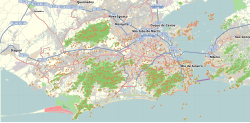Urca
| Urca | |
|---|---|
| Neighborhood | |
 |
|
| Location in Rio de Janeiro | |
| Coordinates: 22°56′56″S 43°09′56″W / 22.94889°S 43.16556°WCoordinates: 22°56′56″S 43°09′56″W / 22.94889°S 43.16556°W | |
| Country |
|
| State | Rio de Janeiro (RJ) |
| Municipality/City | Rio de Janeiro |
| Zone | South Zone |
Urca is a traditional and wealthy residential neighborhood with nearly 7,000 inhabitants (2000 census) in Rio de Janeiro, Brazil. Although most of the neighborhood dates from the 1920s, parts of it are much older. What is now called the Forte São João, a military base at the foot of the Sugarloaf Mountain, is where the first Portuguese settlement in Rio was founded by Estácio de Sá on March 1, 1565. The French had arrived 12 years earlier and founded a settlement, called France Antarctique, close to what is now Flamengo and Gloria districts, in downtown Rio. The French, riven by internal disputes between Catholics and Protestants, were massacred by the Portuguese and their Indian allies in attacks organised from here, expelling them from the nearby Villegagnon Island (named after the French commander Nicolas Durand de Villegaignon). The street now called Rua São Sebastião, in Urca, which leads from behind the fort to the Urca cassino, was originally a trail from the Portuguese fort skirting the edge of the sea to the mainland along the peninsula that houses the Sugar Loaf and a smaller hill, the Morro da Urca. Rua São Sebastião thus has some claim to be the oldest street in Rio.
Building space in Rio is restricted by the city's geography, which offers formidable physical barriers to urban expansion. The notion of filling in part of the shallow bay around the Morro Vermelho and building a neighborhood on it was mooted periodically in the nineteenth century, and in the 1880s a development company was formed for the purpose, Urbanização Carioca, whose acronym Urca gave the neighbourhood its name. But, some historians contest this version, identifying the name Urca already stamped in 18th century maps. "Urca", in old Portuguese tradition, designates a small and large cargo ship. Legal wrangles over financing and land titles delayed work for a generation, but the landfill began shortly after the conclusion of World War I and the first houses were built in 1922. The centrepiece of the new neighbourhood was a cassino, originally conceived as a competitor to the newly installed cassino in the luxury Copacabana Palace hotel, in those days a rather longer and more inconvenient haul from downtown Rio.
...
Wikipedia


